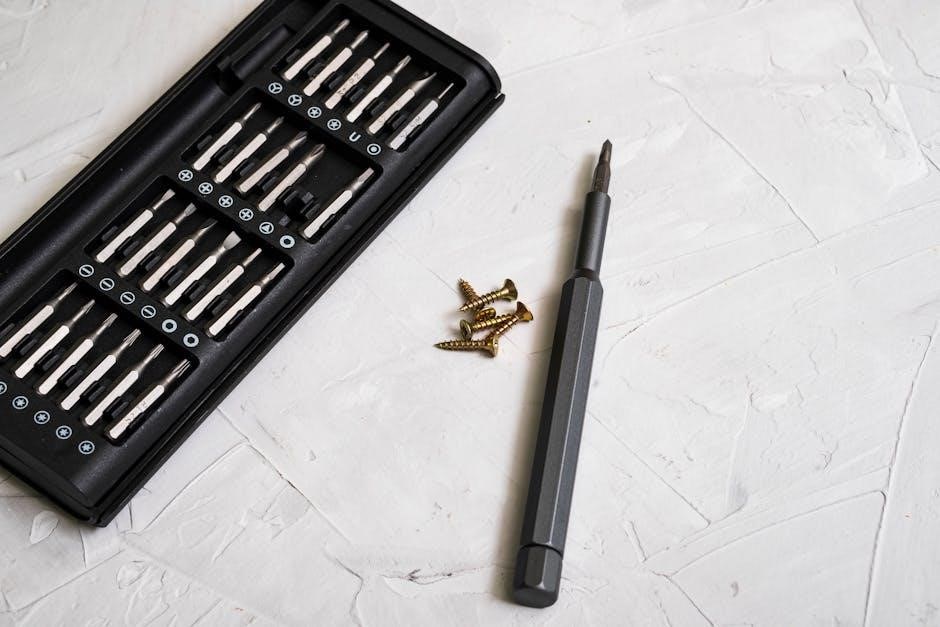LPILE is a software tool for analyzing single piles under lateral loads using the p-y method. It models nonlinear soil resistance and is widely used in geotechnical engineering for assessing deep foundation behavior under various loading conditions, providing accurate results for pile design and analysis.
1.1 Overview of LPILE and Its Purpose
LPILE is a powerful software tool designed to analyze the behavior of single piles under lateral loads. It employs the p-y method to model nonlinear soil resistance, enabling accurate simulations of pile performance. The program is widely used in geotechnical engineering for assessing deep foundations subjected to lateral forces. Its primary purpose is to provide engineers with detailed insights into pile deflection, rotation, and soil interaction, aiding in the design and analysis of reliable deep foundation systems.
1.2 Key Features of LPILE
LPILE offers advanced capabilities for analyzing single piles under lateral loads using the p-y method. Key features include support for various soil models (Soft Clay, Stiff Clay, Sand), nonlinear soil resistance modeling, and factored unit weight (γz) calculations. It provides tools for customizing p-y curves, simulating fixed head conditions, and interpreting detailed results. The software is user-friendly, with a comprehensive interface for inputting soil profiles, pile properties, and lateral load definitions, making it a robust tool for geotechnical engineers designing deep foundations.
1.3 Brief History and Development of LPILE
LPILE was developed by Ensoft, Inc., with its origins rooted in early p-y analysis methods. Over the years, it has evolved to incorporate advanced soil models and nonlinear analysis techniques. Initially designed for academic use, LPILE gained popularity in professional engineering due to its accuracy and versatility. Regular updates have enhanced its capabilities, adding features like factored unit weight calculations and improved user interfaces, solidifying its position as a leading tool in geotechnical engineering for lateral load analysis of deep foundations.

Installing and Setting Up LPILE
Installing LPILE involves downloading the software, running the installer, and following on-screen instructions. Activation requires a valid license key for full functionality. The process is straightforward, ensuring ease of use for engineers and designers.
2.1 System Requirements for LPILE
For optimal performance, LPILE requires a 64-bit Windows operating system (Windows 10 or later), a multi-core processor (Intel i5 or equivalent), and at least 8 GB of RAM. A minimum of 2 GB of free disk space is recommended for installation and operation. Graphics capabilities should support 1024×768 resolution or higher. Ensure the system has the latest .NET Framework installed. Meeting these specifications ensures smooth installation and operation of LPILE for accurate analysis and design.
2.2 Installation Steps for LPILE
To install LPILE, download the installer from the official website and run the executable file. Follow the installation wizard prompts to select the destination folder. Accept the license agreement and proceed with the installation. Once complete, a shortcut will be created on your desktop. Ensure administrative privileges are enabled to avoid installation issues. After installation, verify the version and integrity by launching the software. Refer to the user manual for any specific post-installation configurations.
2.3 Activating the License
After installing LPILE, activate your license to unlock its full features. Launch the software and navigate to the “Help” menu, then select “License Activation.” Enter your provided license key and click “Activate.” For offline activation, download the license file from the LPILE website and import it into the software. Ensure your system has internet access for online activation or follow the offline procedure. Contact support if activation fails or if you encounter any licensing errors during the process.

Getting Started with LPILE
Launch LPILE, navigate through the user-friendly interface, and access guides or tutorials to familiarize yourself with the software. Start by creating a new project or opening an existing one to begin your analysis. Ensure all input data is ready for a smooth workflow. Explore tools and settings to customize your experience and optimize efficiency.
3.1 Creating a New File in LPILE
To create a new file in LPILE, launch the software and select File > New from the menu bar. Choose the appropriate template or project type based on your analysis needs. Enter the project name, location, and other relevant details in the provided fields. Click OK to initialize the new file. The software will open a new workspace where you can start inputting data for your analysis. Use the intuitive interface and built-in wizards to guide you through the setup process smoothly.
3.2 Initializing a Model in LPILE
To initialize a model in LPILE, access the Project menu and select New Model. Define the pile and soil properties, boundary conditions, and analysis parameters in the dialog box. Specify the pile length, diameter, and material type, along with the soil profile and layering details. Import any external data if required. Configure the model settings and click OK to create the model. The software will generate a basic framework ready for detailed input and analysis. Use the graphical interface to visualize and refine the model setup.
3.3 Understanding the User Interface
The LPILE user interface is designed for intuitive navigation, with a logical layout of menus, toolbars, and panels. The main window includes the Menu Bar at the top, providing access to file, edit, and analysis options. Below it, the Toolbar offers quick access to common functions. The central area displays the Input Panels for data entry, while the Results and Graphical Viewer panels show outputs and visualizations. Use the Project Explorer to manage files and the Status Bar for real-time updates. Customize the interface by docking or undocking panels to suit your workflow.

Input Data Requirements
Accurate input of soil properties, pile dimensions, and lateral load details is essential for reliable analysis. Ensure all parameters are correctly entered for precise results.
4.1 Soil Profile and Layering
Accurate soil profile definition is critical in LPILE. Users must input soil layers with their respective depths, types, and properties. Soil types include clay, sand, and others. Each layer requires strength parameters such as undrained shear strength for clay or friction angle for sand. Layering must represent subsurface conditions accurately. Proper input ensures realistic soil-structure interaction modeling. Correct layer definitions are vital for precise analysis results. Always validate soil data before proceeding with the analysis to ensure accuracy and reliability in the final output.
4.2 Pile Properties and Dimensions
In LPILE, defining pile properties and dimensions is essential for accurate analysis. Users must specify the pile’s diameter, length, and material. Other critical inputs include cross-sectional area, moment of inertia, and unit weight. For steel piles, steel grade and section properties are required. Concrete piles need compressive strength and reinforcement details. Accurate pile dimensions ensure proper modeling of bending resistance and deflection. Ensure all inputs are consistent in units and align with the project’s specifications for reliable results. Proper data entry is vital for precise analysis outcomes.
4.3 Lateral Load Definitions
Lateral load definitions in LPILE involve specifying the horizontal forces acting on the pile. These can include static or dynamic loads, such as wind or seismic forces. Users must input the magnitude and distribution of these loads, as well as their direction. Proper definition ensures accurate simulation of pile behavior under various conditions. Accurate input is crucial for obtaining realistic results and reliable analysis outcomes. Misdefinition can lead to incorrect simulations, so careful specification is essential.

Soil Models in LPILE
LPILE offers multiple soil models to simulate soil behavior under lateral loads, including clay and sand models based on empirical correlations and research by experts like Matlock and Reese.
5;1 Soft Clay Model (Matlock, 1970)
The Soft Clay Model in LPILE, developed by Matlock in 1970, is specifically designed for analyzing lateral pile behavior in soft clay soils. This model utilizes empirical correlations derived from extensive field tests to predict soil resistance along the pile. It is particularly useful for soils with low shear strength, where the pile’s lateral response is critical. Engineers can apply this model to simulate the nonlinear soil-pile interaction, ensuring accurate predictions of pile deflections and rotations under various load conditions. This model is essential for geotechnical design and analysis in soft clay environments.
5.2 Stiff Clay Models (Reese et al., 1975)
The Stiff Clay Model by Reese et al. (1975) in LPILE is tailored for analyzing pile behavior in stiff clay soils, characterized by higher shear strength. This model incorporates empirical relationships to predict soil resistance, focusing on nonlinear soil-pile interaction. It is particularly suitable for deep foundations in stiff clay deposits, where accurate prediction of lateral deflections and rotations is critical. The model accounts for the unique stress-strain behavior of stiff clays, enabling precise simulations under various lateral load conditions for reliable geotechnical design.
5.3 Sand Model (Reese et al., 1974)
The Sand Model in LPILE, developed by Reese et al. (1974), is designed to analyze pile behavior in sandy soils. This model incorporates empirical relationships to simulate the nonlinear response of sands under lateral loading. It accounts for soil stiffness, relative density, and frictional resistance, providing accurate predictions of pile deflections. The model is particularly useful for deep foundations in sandy environments, where drained soil behavior and frictional resistance dominate. It ensures reliable simulations for a wide range of geotechnical applications.

P-Y Curve Generation
P-Y curve generation in LPILE is essential for analyzing lateral pile behavior, involving soil properties and load-deflection relationships to ensure accurate design and safety assessments.
6.1 Understanding P-Y Curves
P-Y curves represent the relationship between lateral load (P) and displacement (Y) of a pile in soil. These curves are fundamental in LPILE for assessing pile behavior under lateral forces. Each curve corresponds to a specific soil layer, reflecting soil stiffness and resistance. Accurate P-Y curves ensure reliable design and analysis, enabling engineers to predict deflections and rotations accurately. LPILE automates curve generation based on soil properties and pile characteristics, simplifying the process while maintaining precision for geotechnical applications.
6.2 Criteria for P-Y Curve Calculation
The criteria for P-Y curve calculation in LPILE involve soil properties, pile dimensions, and lateral load magnitude. Soil type, stiffness, and strength parameters are essential for accurate modeling. Pile diameter, embedment depth, and material stiffness also influence the curves. LPILE uses these inputs to define soil-pile interaction, ensuring realistic behavior under lateral loads. The software adheres to established geotechnical principles, providing reliable results for design and analysis purposes while maintaining user-defined constraints for customization and precision. This ensures robust and accurate P-Y curve generation.
6.3 Customizing P-Y Curves
LPILE allows users to customize P-Y curves by adjusting soil parameters, pile properties, and lateral load factors. Soil stiffness, strength, and damping ratios can be modified to match site-specific conditions. Pile diameter, embedment depth, and flexural rigidity can also be refined. Additionally, users can define custom failure criteria and input p-multipliers for advanced analysis. These features enable precise tailoring of P-Y curves to project requirements, ensuring accurate and reliable results for pile design and performance evaluation.

Analyzing Lateral Load Behavior
LPILE enables detailed analysis of pile behavior under lateral loads, providing insights into deflection, bending moment, and soil resistance. Users can define load cases and analyze results.
7.1 Running the Analysis
Running the analysis in LPILE involves selecting the appropriate solver and input parameters. Users can initiate the analysis by clicking the “Run” button. The software validates input data and performs calculations based on defined soil models and pile properties. A progress bar indicates the analysis status. Upon completion, results are displayed, including deflection, bending moment, and shear force diagrams. Output files are generated for further review and post-processing. Ensure all inputs are accurate for reliable results.
7.2 Interpreting Results
Interpreting results in LPILE involves analyzing the computed deflection, bending moment, and shear force diagrams. These plots illustrate the pile’s response to lateral loads at various depths. Users can assess whether the design meets safety criteria by comparing results with allowable limits. Graphical outputs and data tables provide detailed insights. It is essential to review error messages or warnings, as they indicate potential issues in the analysis. Accurate interpretation ensures reliable performance evaluation and informs design adjustments if necessary.
7.3 Validation of Results
Validating results in LPILE ensures accuracy and reliability. Users should compare computed values with design specifications and expected behavior. Check for consistency in deflection, bending moments, and shear forces. Review error messages and warnings to identify discrepancies. Cross-verify with manual calculations or alternative software if needed. Validate soil models and input parameters to ensure they align with site conditions. Accurate validation prevents design errors and ensures compliance with engineering standards, ultimately enhancing the safety and performance of the pile design.

Advanced Features in LPILE
LPILE offers advanced tools for dynamic analysis, multi-pile interactions, and 3D modeling, enhancing precision in complex geotechnical scenarios while maintaining user-friendly interfaces for engineers.
8.1 Fixed Head and Rotation/Deflection Settings
LPILE allows users to define boundary conditions for pile analysis, including fixed head and rotation/deflection settings. These settings enable engineers to model piles with varying degrees of rotational and translational restraint. The fixed head option simulates a pile with no rotation or translation, while the rotation/deflection settings provide flexibility for analyzing piles under different loading scenarios. These features are essential for accurately modeling real-world pile behavior, ensuring precise results in lateral load analysis and design.
8.2 Factored Unit Weight (γz) Calculation
The factored unit weight (γz) in LPILE is a critical parameter for soil-structure interaction analysis. It represents the unit weight of soil adjusted by a safety factor to account for uncertainties. Accurate γz values ensure precise modeling of soil resistance. LPILE automates γz calculation based on input soil properties, simplifying the process for engineers. Proper γz values are essential for obtaining reliable results in lateral load analysis, enhancing the overall design accuracy, safety, and reliability of deep foundation systems.
8.3 Nonlinear Soil Resistance Modeling
Nonlinear soil resistance modeling in LPILE allows for accurate representation of soil behavior under lateral loading. This feature accounts for the nonlinear relationship between soil resistance and pile deflection, enabling more realistic simulations. Engineers can select from various soil models to match site-specific conditions. The software integrates this modeling with other analysis tools, ensuring comprehensive evaluation of pile performance. This capability enhances the accuracy of lateral load analysis, making it indispensable for complex foundation design projects.

Troubleshooting Common Issues
This section addresses common issues encountered in LPILE, such as error messages, data input problems, and analysis inconsistencies. It provides solutions and diagnostic tips for users.
9.1 Resolving Errors in Soil Modeling
Soil modeling errors often arise from incorrect input parameters or mismatched soil types. Users should verify layer depths, soil properties, and unit weights. Check for inconsistencies in soil classification and ensure compliance with predefined models. If errors persist, re-import soil data or consult the technical manual for guidance. Resetting default settings may also resolve issues. Regularly updating the software can address bugs affecting soil modeling accuracy.
9.2 Addressing Pile Performance Anomalies
Pile performance anomalies, such as unexpected displacements or rotations, often stem from incorrect input parameters or misdefined boundary conditions. Verify pile dimensions, material properties, and constraint settings. Ensure lateral load inputs align with project specifications. Check for inconsistencies in pile-soil interaction modeling. Validate results by comparing with manual calculations or case studies. If issues persist, review the soil profile and pile geometry for accuracy. Refer to the technical manual for examples and troubleshooting guides specific to pile performance analysis.
9.3 Seeking Support and Resources
For assistance with LPILE, users can contact the official support team via email or through the software’s built-in helpdesk. Extensive online resources, including tutorials and FAQs, are available on the official website. The technical manual provides detailed explanations of features and troubleshooting. Additionally, attending webinars or training sessions can enhance proficiency. Engaging with user forums and communities allows for peer-to-peer problem-solving and shared insights. Regularly check for software updates and documentation revisions to stay informed.

Best Practices for Using LPILE
Adhere to input accuracy, validate results, and use updated software versions. Regularly review the technical manual and consult support resources for optimal analysis.
10.1 Data Input Accuracy
Ensure all input data, including soil properties, pile dimensions, and load conditions, are precise and consistent with project specifications. Double-check units and formatting to avoid errors. Review soil layering and lateral load definitions carefully, as inaccuracies can significantly affect analysis results. Validate inputs against field data or laboratory tests when possible. Maintain detailed documentation of input parameters for future reference and traceability. Accurate data entry is critical for reliable and meaningful LPILE analysis outcomes.
10.2 Regular Software Updates
Regularly updating LPILE ensures access to the latest features, bug fixes, and performance improvements. Updates often include enhanced soil models, improved analysis tools, and compatibility with new operating systems. Subscribe to update notifications and check the official website periodically. Keeping the software current ensures optimal functionality and accuracy in analyses. outdated versions may lack critical security patches or support for new input formats, potentially leading to compatibility issues or inaccurate results. Stay updated to maintain reliability and efficiency in your workflows.
10.3 Consulting the Technical Manual
Consulting the LPILE technical manual is essential for mastering the software. It provides detailed explanations of soil models, input parameters, and analysis methods. The manual includes step-by-step guides, example problems, and troubleshooting tips. Refer to it for clarification on advanced features like nonlinear soil resistance or factored unit weight calculations. Regularly reviewing the manual ensures proper use of tools and interpretation of results, helping users avoid common pitfalls and optimize their workflows for accurate and efficient analysis.
This concludes the LPILE user manual. We hope it has provided a comprehensive guide to using LPILE effectively. Happy analyzing!
11.1 Summary of Key Features
LPILE is a powerful tool for analyzing deep foundations under lateral loads. It offers advanced soil models, including soft clay, stiff clay, and sand, ensuring precise simulations. The software generates P-Y curves, enabling detailed load-displacement analyses. With user-friendly interfaces and robust computational capabilities, LPILE supports both fixed and free-headed piles. Its ability to handle nonlinear soil resistance and factored unit weight calculations makes it indispensable for engineers. Regular updates and comprehensive technical support further enhance its utility, making LPILE a cornerstone in geotechnical engineering.
11.2 Future Developments in LPILE
Future updates to LPILE aim to enhance usability and expand analytical capabilities. Plans include improved 3D modeling for complex soil-pile interactions and integration of machine learning for predictive analyses. Enhanced reporting tools and cloud-based collaboration features are also in development. Additionally, LPILE will incorporate more advanced soil models and real-time data visualization to streamline workflows. These updates ensure LPILE remains at the forefront of geotechnical engineering software, addressing evolving industry demands and user needs effectively.
11.3 Final Tips for Effective Use
To maximize efficiency with LPILE, always ensure input data accuracy and validate results against known standards. Regularly review and update soil models to reflect site-specific conditions. Explore advanced features like nonlinear soil resistance modeling for precise analyses. Consult the technical manual for detailed guidance and participate in training webinars for optimal utilization. By adhering to best practices and staying informed, users can unlock LPILE’s full potential for reliable and accurate geotechnical design solutions.
